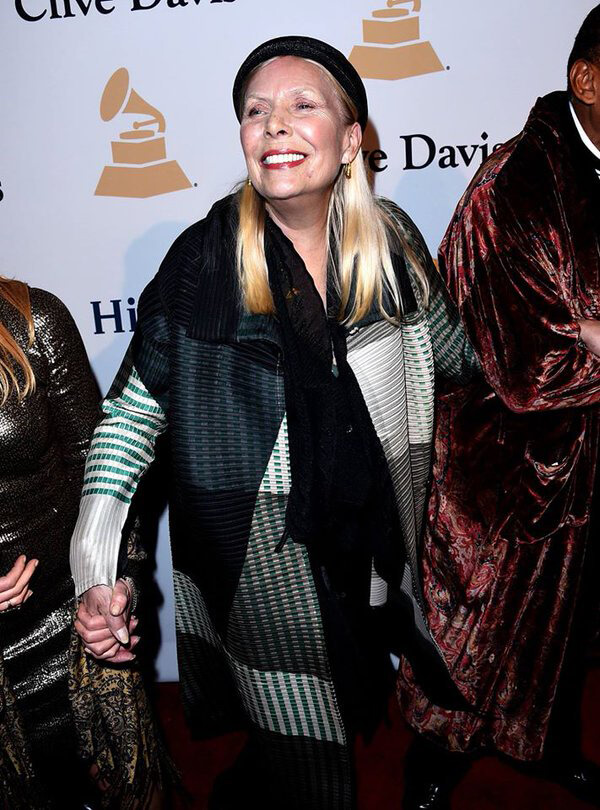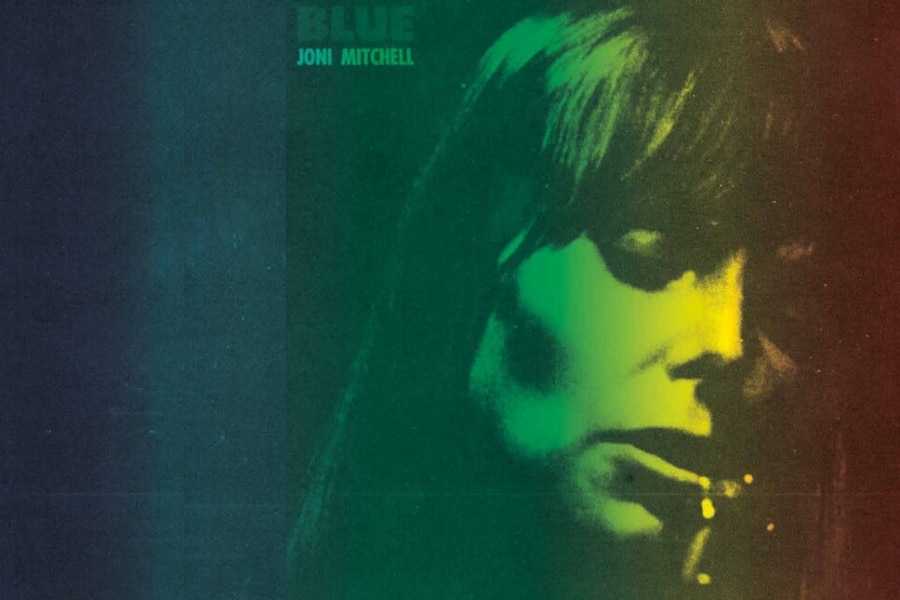Editor’s Note: Joni Mitchell’s album Blue was released in June 1971. Written and produced entirely by Mitchell, the album is one of the most influential works in history. Rolling Stone rated it as the third most important album of all time; the New York Times chose Blue as one of the 25 albums that represented “turning points and pinnacles in 20th-century popular music.” Here, Sheila Weller—who is kind of an expert on Joni Mitchell (and Carly Simon and Carole King)—looks at Mitchell’s legacy.
***
On an early November day in 1966, a tall, thin, Nordic-Celtic vision in a minidress and clunky heels, hunched over the microphone at the Second Fret coffeehouse in Philadelphia, and against her then-husband’s wishes, she sang the songs she was beginning to write in great creative gusts. It was the moment that Joni Mitchell—a wounded, determined runaway from a complicated childhood in the Canadian prairies and soon enough from an unhappy marriage–became a star.
Soon she went off to Laurel Canyon—at first with a smitten David Crosby, but always charting her own course—and the rest would be history. Her life lessons made for the beautiful songs she wrote. There was the pain of having had polio as a child, gruffly cared for by nuns who minced no words about if she would ever walk again. (She proved to them she would.) And the melodrama and guilt—and bravery and integrity—of having endured a secret pregnancy alone and in poverty, subsisting on doughnuts and pizza in a Toronto rooming house. Yet she refused to stop performing nightly in coffee houses, continuing as close as possible to the day she gave birth in the shame-shrouded unwed-mother’s wing of a hospital. She gave the infant girl up for adoption (decades later, mother and daughter would reunite). Her early songs, “The Circle Game” and “Both Sides Now,” had a poignant wisdom far older than her years.
Today—54 years since her star-is-born performance at the Second Fret—Joni Mitchell, 77, is wiser and tougher. She has made an excellent recovery from a serious aneurysm she suffered in April 2015. And she is widely considered one of the most significant singer-songwriters in the country. Here is what I think makes her so important.
Joni Mitchell: The Lyrics You’ll Never Forget

Joni at a pre-Grammy party in 2015. Image: JoniMitchell.com/Twitter
First of all, she is a real poet, not a lyricist almost good enough to be a poet. Her sentiments can be filled with witty double-entendres. (“I could drink a case of you and still be on my feet.”) They can be poignantly and identifiably depressed. (“I’m selfish and I’m sad … I wish I had a river/to skate away on.”) They can be cynical but funny. (“I am as constant as a morning star/Constantly in the darkness—where’s that at? If you want me I’ll be in the bar.”)
They can be country-music-song worthy, their truth hiding in plain sight. (“But when he’s gone/me and my lonesome blues collide/The bed’s too big, the frying pan’s too wide”). They can be character-limning (“Coyote’s in the coffee shop, staring a hole in his scrambled eggs/He picks up my scent on his fingers/as he watches the waitress’s legs,” she wrote in one of my favorite songs of hers, Coyote, which is about the late Sam Shepard.) These poetics were unparalleled in rock music. Many think she runs a second to Bob Dylan; I would put her first, and I am not alone.
Always Charting Her Own Path
Secondly, she is a natural risk-taker. She has always eschewed safety, both artistic and emotional. Right after she achieved fame and had new superstar Graham Nash madly in love with her, she left L.A. to live in a cave on a Greek island with a charming, arrogant “nobody.” “She needed her life to be harder,” is how her friend—and one of her “Ladies of the Canyon”—Estrella Berosini put it.
Likewise, some years later—right after completing her most commercially successful album, Court and Spark, she chucked it all. Like some anonymous hippie or college kid rather than the famous long-time Bel Air-dwelling eminence she’d become, she drove cross-country, alone, in a crazy red wig, picking up hitchhikers and composing the magnificent songs—about blue motel rooms, gas stations with mythic portent, and Winn Dixies—of Hejira.
When she had reached a “branded” fame in one perfected genre—confessional singer-songwriting—she threw away the template and moved to esoteric jazz, creating innovative albums, like Don Juan’s Reckless Daughter, that at first confused and alienated her safe, trusted fan base but proved her to be an absolute jazz talent.
Capturing the Zeitgeist
Third, she is a sociologist. Roy Blumenfeld, an early lover and the drummer for the Blues Project, called Joni “a scientist of love.” She is that, but she is also an astute assayer of her generation. “For Free” laments capitalism and extols artistry and idealism. “Ladies of The Canyon” described an entire phenomenon of female: the long-skirted, tarot-tossing, cake-baking “earthmother” who so many girls wanted to be. “Big Yellow Taxi” was an ode to environmentalism, and “Woodstock” captured a group-grope idealism that every account other than hers has rendered corny.
Only in Joni’s almost Biblical wording (Camille Paglia ranked “Woodstock” as one of the greatest poems ever written) was that event ennobled to the dream of what all those mud-revelers meant it to be. Finally, “Both Sides Now”—especially Judy Collins’ 1969 hit version, with the tinkling feminine calliopes—was for young women of the era what Frank Sinatra’s “My Way” was for end-of-Mad Men-era guys.
Read More: Carly Simon and Sally Taylor on Creativity, Love—and No Secrets
Defining a New Way of Being a Woman
For me, her biggest accomplishment is modeling a new way of being a woman. She wrote the recipe for being on your own, risking in love, being willing to lose, but never losing more than you win: “She will love them when she sees them/they will lose her if they follow/And she only means to please them/and her heart is full and hollow like a cactus tree.”
For women who were young when the ’60s turned to the ’70s, there was a before-Joni-Mitchell and an after-Joni-Mitchell—her image, music, and magic were enough to make many girls confident believers in what was then called free love but also to fill them with dignity. The pretty milkfed woman at the Second Fret of all those Novembers ago gave us a lot.
A version of this piece was originally published in November 2018.
***
Sheila Weller is the author of seven books (three of them New York Times Bestsellers), the best of which is Girls Like Us: Carole King, Joni Mitchell, Carly Simon—and the Journey of a Generation, which Billboard magazine recently named #19 of the best music books of all time. She has been writer of major features for Vanity Fair, a recent longtime senior contributing editor at Glamour, a has written for the New York Times Opinion, Styles and Book Review and for just about every women’s magazine in existence. She has won 10 major magazine awards.





















0 Comments